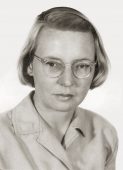
The story of a remarkable woman scientist, little known for her pioneering work in radar and radio-astronomy, and perhaps even less for the difficulties she faced with the antiquated employment laws in Australia at the time. This is a brief look at the woman and her work, followed by the ridiculous impositions on women seeking employment in the male-dominated society of just 50 years ago.
Born at Grafton in May 1912, Ruby was educated at Penrith Public School before going on to Cleveland Street and Sydney Girls’ High School. Her grades proved her a top student. Her school leaving certificate, with specialties in mathematics and botany, earned scholarships enabling her to attend the University of Sydney. Frequently the only woman in her classes, she went on to First Class Honours in mathematics and physics, gaining her B.SC. in 1933, M.Sc. in 1936 and Dip.Ed. in 1938.
Through the late 18th and 19th centuries, pioneering work by Volta, Faraday, Maxwell and Hertz aided Max Planck’s breakthrough that led to quantum physics, the primary field for in-depth study of electromagnetic radiation. From this, astronomical observations were made possible allowing us to measure outside the optical range on the electromagnetic spectrum. This became a basis for Ruby’s field of expertise.

Despite worldwide depression creating an impact on Australian employment, Ruby obtained a position as a physicist at the University of Sydney, researching the newly discovered radiation treatment for cancer sufferers. It was while there she completed her Master’s thesis on specific aspects of wavelength distribution in X-rays and gamma rays.
With no further scientific posts available, she turned to teaching, spending two years at Adelaide’s Woodlands Church of England Girls’ Grammar School. She returned to Sydney in 1939 to take up a position with Amalgamated Wireless (Australia) – AWA – as librarian. With her educational background and already proven scientific work experience, it was not long before she became a member of the professional staff
This was followed, through World War Two, by Ruby and her contemporary Dr Joan Freeman finding employment, due to wartime manpower shortages, in the CSIR (later to become the CSIRO). They became the first female physicists employed in the Radiophysics Laboratory. In the early days, their work classified ‘Top Secret,’ they played an important role in the development of a radar network produced from ‘sticky tape and coat-hangers’ that protected Australia’s coastline.
As a continuance of this, she became a member of the team that developed ways of measuring radio emissions from the heavens. A passionate researcher, she was an important member of the groundbreaking Australian team that followed the work of Planck and others and led to the construction of highly sophisticated radio telescopes. From this came the term radio astronomy.
Despite it lasting little more than a decade, Ruby’s work was important, and yet it failed to protect her from employment rules that were, even then, antiquated.
It mattered not Ruby Payne-Scott’s preeminence in the scientific field – the work she had done in pioneering a new science – political beliefs, marriage and child-bearing were to get in the way of her continued employment. As a member of the Communist Party, ASIO maintained a file on her. Remember, this was back in the days of the Cold War and McCarthyism in the US: anything or anyone with even a hint of pink was treated with distrust and investigated. Despite suspicions and innuendo, ASIO could prove nothing against her beyond party membership.
Until an amendment only 50 years ago, in November 1966, the Public Service Act required women in the public service to resign when they married. They were expected to assume temporary positions that bore poor career prospects and few if any entitlements. Ruby had married Peter Hall in secret in 1944 but by 1951, ever more obviously pregnant, she was ‘obliged’ to leave the (by then) CSIRO. She was never to return. This brilliant woman scientist turned her hand to being an exceptional mother, returning to teaching science after ten years as her children grew and developed.
Ruby died in May 1981. Fittingly, one of her legacies is the CSIROs Payne-Scott Award, assisting researchers who take career breaks to care for family to re-enter their field.
As an aside: One of those with whom Ruby-Payne Scott had a work association was Joan Sutherland, a highly talented young woman who went on to international fame in an entirely different field.
